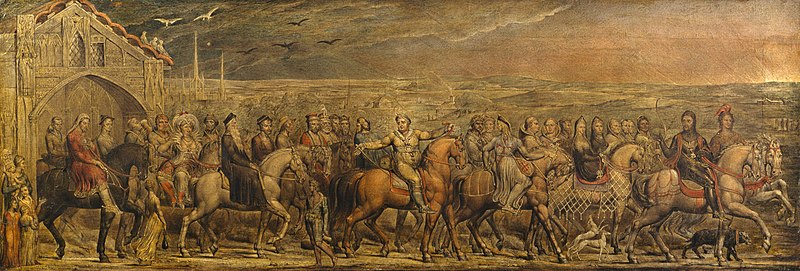 |
| Wikipedia Commons Canterbury Pilgrims |
Descriptive Catalogue, (E 532)
"NUMBER III.
Sir Jeffery Chaucer and the nine and twenty Pilgrims on
their journey to Canterbury.
THE time chosen is early morning, before sunrise, when the jolly
company are just quitting the Tabarde Inn. The Knight and Squire
with the Squire's Yeoman lead the Procession, next follow the
youthful Abbess, her nun and three priests; her greyhounds attend
her.
'Of small hounds had she that she fed
'With roast flesh, milk and wastel bread.'
Next follow the Friar and Monk; then the Tapiser, the Pardoner,
and the Somner and Manciple. After these "Our Host," who occupies
the center of the cavalcade; directs them to the Knight
as the person who would be likely to commence their task of each
telling a tale in their order. After the Host follow the
Shipman, the Haberdasher, the Dyer, the Franklin, the Physician,
the Plowman, the Lawyer, the poor Parson, the Merchant, the Wife
of Bath, the Miller, the Cook, the Oxford Scholar, Chaucer
himself, and the Reeve comes as Chaucer has described:
'And ever he rode hinderest of the rout.'
These last are issuing from the gateway of the Inn; the Cook and
the Wife of Bath are both taking their morning's draught of
comfort. Spectators stand at the gateway of the Inn, and are
composed of an old Man, a Woman and Children.
The Landscape is an eastward view of the country, from the
Tabarde Inn, in Southwark, as it may be supposed to have
appeared in Chaucer's time; interspersed with cottages and
villages; the first beams of the Sun are seen above the horizon;
some buildings and spires indicate the situation of the great
City; the Inn is a gothic building, which Thynne in his Glossary
says was the lodging of the Abbot of Hyde, by Winchester. On
the Inn is inscribed its title, and a proper advantage is taken
of this circumstance to describe the subject of the Picture.
The words written over the gateway of the Inn, are as follow:
"The Tabarde Inn, by Henry Baillie, the lodgynge-house for
Pilgrims, who journey to Saint Thomas's Shrine at Canterbury."
The characters of Chaucer's Pilgrims are the characters
which compose all ages and nations: as one age falls, another
rises, different to mortal sight, but to immortals only the same;
for we see the same characters repeated again and again, in
animals, vegetables, minerals, and in men; nothing new occurs in
identical existence; Accident ever varies, Substance can
never suffer change nor decay.
Of Chaucer's characters, as described in his Canterbury
Tales, some of the names or titles are altered by time, but the
characters themselves for ever remain unaltered, and
consequently they are the
physiognomies or lineaments of universal human life, beyond which
Nature never steps. Names alter, things never alter. I have
known multitudes of those who would have been monks in the age of
monkery, who in this deistical age are deists. As Newton
numbered the stars, and as Linneus numbered the plants, so
Chaucer numbered the classes of men."
There were many reasons that Blake put a lot of time and energy into his painting of the Canterbury Pilgrims, some of which we will explore in later posts. First we see it only as a careful rendition of a Gothic text.
.
No comments:
Post a Comment